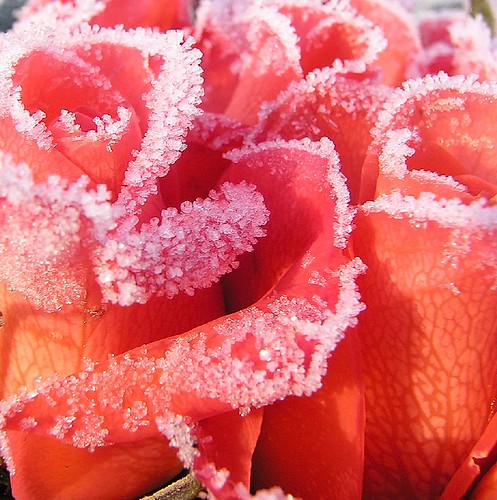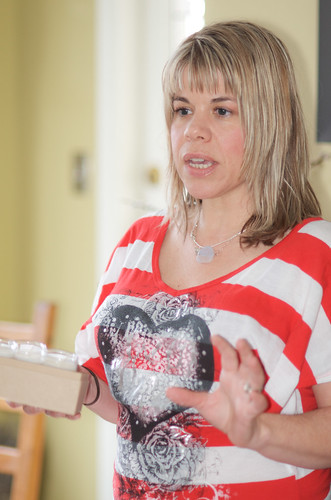Cerise en Cocoa
Cerise en Cocoa is the other Rebel & Mercury's other osmanthus-laden perfume Nikki sent me to try before our osmanthus conversation, this time in an oil-base parfum concentration.
It is not nearly as osmanthus-y as Osmanthus Red, but is noteworthy for its stellar pairing of a difficult trio: rose, osmanthus and chocolate.
Rose and osmanthus together are extremely difficult to work with. When they have been paired in the past, the result was a rich-heavy-nearly-muddy concoction. Masterfully blended it will result in melancholy darkness such as that present in 1000 de Patou. Not so well done it is just sheer cacophony - every perfumer's nightmare.
Somehow, in Cerise en Cocoa, Nikki Sherritt was able to pull the best of each component and work them together in a balancing act that brings to mind an acrobat dancer on a tightrope. And not just any acrobat - but the legendary Rosa Marzipan herself (a beloved Erich Kästner heroine). Pretty and flexible, with a delicate almond-paste complexion and while her head is nearly always in the air, her head is grounded in reason and wit.
Cerise en Cocoa (cherry and cocoa) begins with a burst of unusual fruitiness - the plum-like, robust juiciness of osmanthus absolute combined with an even juicier ruby-red grapefruit zest and both bring forth the the peach-plum damascones in red and white roses. The wine-like, liquor qualities of cocoa absolute also contribute to the sensual feeling of biting into a Pierre Herme violet-cassis macaron, with the thin brittle skin bursting open to reveal a lightly fragranced, creamy almond paste underneath and a cassis-flavoured silky ganache undnerneath.
Yet, all this apparent sweetness is well-balanced with an underlying dry air of woodsy vetiver roots. There is almost a dry feeling of pencil shavings, so there might be some Virginia cedar lurking beneath too.
Cerise en Cocoa is available directly from Rebel & Mercury's Etsy shop; or via Sweet Anthem in Seattle.
Top notes: Ruby Red Grapefruit, Virginia Cedarwood
Heart notes: Osmanthus, White and Red Rose accord
Base notes: Cocoa, Vetiver
It is not nearly as osmanthus-y as Osmanthus Red, but is noteworthy for its stellar pairing of a difficult trio: rose, osmanthus and chocolate.
Rose and osmanthus together are extremely difficult to work with. When they have been paired in the past, the result was a rich-heavy-nearly-muddy concoction. Masterfully blended it will result in melancholy darkness such as that present in 1000 de Patou. Not so well done it is just sheer cacophony - every perfumer's nightmare.
Somehow, in Cerise en Cocoa, Nikki Sherritt was able to pull the best of each component and work them together in a balancing act that brings to mind an acrobat dancer on a tightrope. And not just any acrobat - but the legendary Rosa Marzipan herself (a beloved Erich Kästner heroine). Pretty and flexible, with a delicate almond-paste complexion and while her head is nearly always in the air, her head is grounded in reason and wit.
Cerise en Cocoa (cherry and cocoa) begins with a burst of unusual fruitiness - the plum-like, robust juiciness of osmanthus absolute combined with an even juicier ruby-red grapefruit zest and both bring forth the the peach-plum damascones in red and white roses. The wine-like, liquor qualities of cocoa absolute also contribute to the sensual feeling of biting into a Pierre Herme violet-cassis macaron, with the thin brittle skin bursting open to reveal a lightly fragranced, creamy almond paste underneath and a cassis-flavoured silky ganache undnerneath.
Yet, all this apparent sweetness is well-balanced with an underlying dry air of woodsy vetiver roots. There is almost a dry feeling of pencil shavings, so there might be some Virginia cedar lurking beneath too.
Cerise en Cocoa is available directly from Rebel & Mercury's Etsy shop; or via Sweet Anthem in Seattle.
Top notes: Ruby Red Grapefruit, Virginia Cedarwood
Heart notes: Osmanthus, White and Red Rose accord
Base notes: Cocoa, Vetiver



